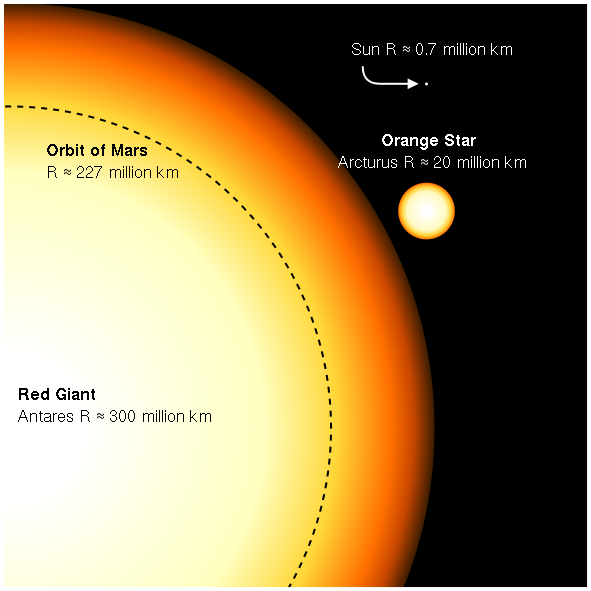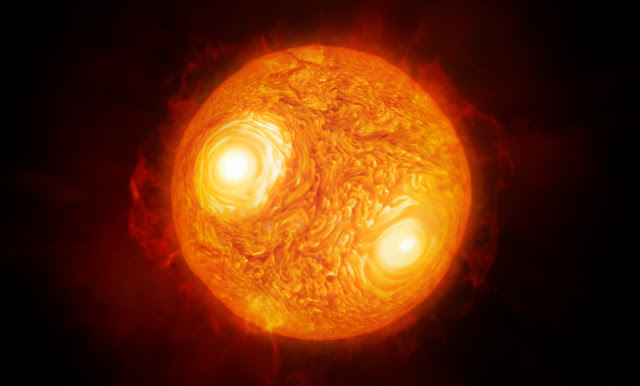
These next few evenings – July 1 and 2, 2020 – let the moon introduce you to Antares. It’s a red star and the brightest star in the constellation Scorpius the Scorpion. Look first for the moon, and the nearby bright star will be Antares.
Any red-looking star that you can see with the unaided eye is either a red giant or red supergiant star. Antares is a red supergiant. This star, which is in the autumn of its years, is expected to explode as a supernova one of these days. No telling when that will be, however. It could happen tomorrow or a million years from now.
Although Antares lies way out there, at some 600 light-years distant, this star easily shines at 1st-magnitude brightness. In order to beam so brightly in our sky, this star must be extremely luminous, that is, intrinsically very brilliant as opposed to merely appearing bright because of a nearer distance.
Antares’ red color indicates a relatively cool surface temperature, and cool stars shine less brilliantly than hot stars of the same size. But Antares is just so big! Its sheer size makes this star more luminous than many stars with higher surface temperatures.

If Antares replaced the sun in our solar system, its circumference would extend beyond the orbit of the fourth planet, Mars. In this illustration, Antares is shown in contrast to another star, Arcturus, and our sun. Image via Wikimedia Commons.
Just how large is this incredible star? It’s not known with absolute certainty, but its radius is thought to be about three times the Earth’s distance from the sun (3 astronomical units). That’s about 3/5 the way from the sun to the orbit of Jupiter, the fifth planet outward from the sun. The radius of Antares is the equivalent of approximately 650 solar radii.
Presuming a radius of 650 solar radii and therefore a diameter of 650 solar diameters, that means the surface area of Antares exceeds that of our sun by some 122,500 times (Antares’ surface area = 650 x 650 = 122,500 solar). But Antares’ volume is actually a few hundred million times greater than the sun’s (Antares’ volume = 650 x 650 x 650 = 271,630,000 solar). And just to think that the sun has the volume of 1,300,000 Earths!

This artist’s concept shows the red supergiant star Antares in the constellation Scorpius. Image via ESO/ M. Kornmesser.
Bottom line: These next two evenings – July 1 and 2, 2020 – let the moon be your guide to Antares, a red supergiant star whose humongous size is truly difficult to fathom!
from EarthSky https://ift.tt/2BuAjEt

These next few evenings – July 1 and 2, 2020 – let the moon introduce you to Antares. It’s a red star and the brightest star in the constellation Scorpius the Scorpion. Look first for the moon, and the nearby bright star will be Antares.
Any red-looking star that you can see with the unaided eye is either a red giant or red supergiant star. Antares is a red supergiant. This star, which is in the autumn of its years, is expected to explode as a supernova one of these days. No telling when that will be, however. It could happen tomorrow or a million years from now.
Although Antares lies way out there, at some 600 light-years distant, this star easily shines at 1st-magnitude brightness. In order to beam so brightly in our sky, this star must be extremely luminous, that is, intrinsically very brilliant as opposed to merely appearing bright because of a nearer distance.
Antares’ red color indicates a relatively cool surface temperature, and cool stars shine less brilliantly than hot stars of the same size. But Antares is just so big! Its sheer size makes this star more luminous than many stars with higher surface temperatures.

If Antares replaced the sun in our solar system, its circumference would extend beyond the orbit of the fourth planet, Mars. In this illustration, Antares is shown in contrast to another star, Arcturus, and our sun. Image via Wikimedia Commons.
Just how large is this incredible star? It’s not known with absolute certainty, but its radius is thought to be about three times the Earth’s distance from the sun (3 astronomical units). That’s about 3/5 the way from the sun to the orbit of Jupiter, the fifth planet outward from the sun. The radius of Antares is the equivalent of approximately 650 solar radii.
Presuming a radius of 650 solar radii and therefore a diameter of 650 solar diameters, that means the surface area of Antares exceeds that of our sun by some 122,500 times (Antares’ surface area = 650 x 650 = 122,500 solar). But Antares’ volume is actually a few hundred million times greater than the sun’s (Antares’ volume = 650 x 650 x 650 = 271,630,000 solar). And just to think that the sun has the volume of 1,300,000 Earths!

This artist’s concept shows the red supergiant star Antares in the constellation Scorpius. Image via ESO/ M. Kornmesser.
Bottom line: These next two evenings – July 1 and 2, 2020 – let the moon be your guide to Antares, a red supergiant star whose humongous size is truly difficult to fathom!
from EarthSky https://ift.tt/2BuAjEt

Aucun commentaire:
Enregistrer un commentaire